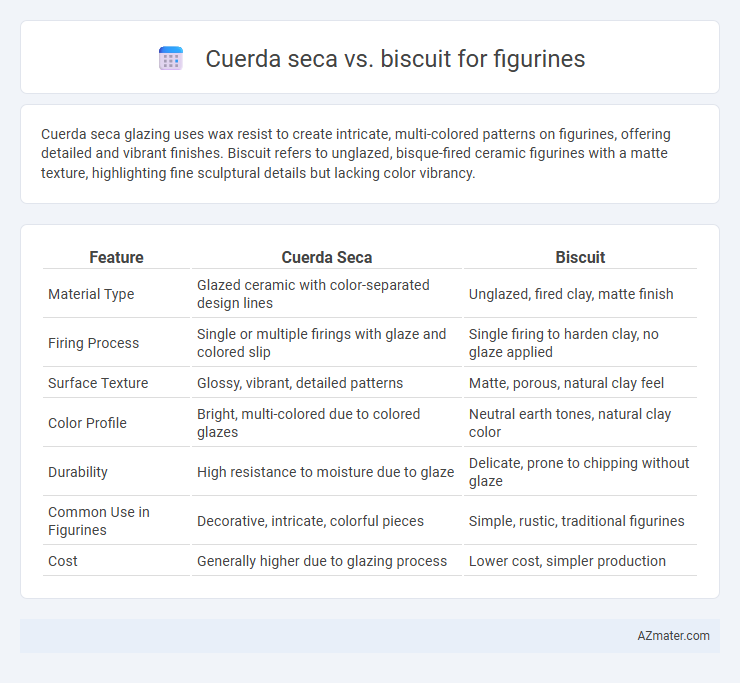Cuerda seca glazing uses wax resist to create intricate, multi-colored patterns on figurines, offering detailed and vibrant finishes. Biscuit refers to unglazed, bisque-fired ceramic figurines with a matte texture, highlighting fine sculptural details but lacking color vibrancy.
Table of Comparison
| Feature | Cuerda Seca | Biscuit |
|---|---|---|
| Material Type | Glazed ceramic with color-separated design lines | Unglazed, fired clay, matte finish |
| Firing Process | Single or multiple firings with glaze and colored slip | Single firing to harden clay, no glaze applied |
| Surface Texture | Glossy, vibrant, detailed patterns | Matte, porous, natural clay feel |
| Color Profile | Bright, multi-colored due to colored glazes | Neutral earth tones, natural clay color |
| Durability | High resistance to moisture due to glaze | Delicate, prone to chipping without glaze |
| Common Use in Figurines | Decorative, intricate, colorful pieces | Simple, rustic, traditional figurines |
| Cost | Generally higher due to glazing process | Lower cost, simpler production |
Introduction to Figurine Glazing Techniques
Cuerda seca and Biscuit represent two distinct glazing techniques used in figurine artistry, each offering unique aesthetic and textural qualities. Cuerda seca involves outlining designs with a greasy resist to separate colors during glazing, resulting in vibrant, precise patterns, while Biscuit refers to unglazed, bisque-fired porcelain that showcases a matte, natural finish emphasizing form and detail. Understanding these methods is essential for artists aiming to balance color dynamics with surface texture in figurine creation.
What is Cuerda Seca?
Cuerda seca is a traditional ceramic glazing technique that uses a greasy, waxy resist to separate different colored glazes during firing, preventing colors from mixing and creating defined, intricate patterns. This method contrasts with biscuit firing, where the ceramic piece is first fired unglazed to a porous state before applying glazes in a second firing. Cuerda seca is prized for its vivid, multicolored designs and sharp outlines on decorative figurines.
What is Biscuit Firing?
Biscuit firing is the initial kiln firing process for unglazed ceramic figurines, where the clay is hardened at a lower temperature, typically between 900degC and 1000degC, to create a durable, porous form called "biscuit" or "bisque." This stage removes moisture and organic materials, preparing the figurine for glazing or decoration without altering its shape. In contrast, the cuerda seca technique involves a specialized glazing method using wax resist lines to separate colors, but it relies on fully fired, vitrified ceramics rather than the porous state achieved through biscuit firing.
Historical Origins: Cuerda Seca vs. Biscuit
Cuerda seca, originating in 10th-century Islamic Spain, is a ceramic technique known for its distinctive colored glazes separated by greasy lines preventing colors from mixing, used extensively in tilework and figurines. Biscuit, also called bisque, emerged in 18th-century European porcelain manufacturing, characterized by unglazed, matte-fired porcelain figurines prized for their delicate, lifelike texture. The historical roots of cuerda seca are deeply tied to Moorish art, while biscuit reflects the evolution of European porcelain artisanship during the Rococo period.
Surface Effects and Visual Appeal
Cuerda seca technique creates vibrant, sharp, and colorful surface effects on figurines by using oily resist lines to separate different glazes, resulting in a glossy and intricate finish that enhances visual depth. Biscuit, or unglazed porcelain, offers a matte and smooth texture emphasizing form and subtle details, providing a natural, understated elegance that highlights sculptural quality rather than surface decoration. The cuerda seca method appeals to those seeking rich, decorative vibrancy, while biscuit is favored for minimalist, tactile beauty and organic visual appeal.
Material Compatibility and Preparation
Cuerda seca technique requires porous ceramic surfaces that absorb slip and resist glaze mixing, favoring earthenware or low-fire clays for compatibility. Biscuit firing involves unglazed, fully vitrified clay bodies like stoneware or porcelain, which must be carefully cleaned and prepared to accept decoration without surface contamination. Proper surface preparation in cuerda seca prevents color bleeding, while biscuit figurines demand smooth, dry surfaces for optimal pigment adhesion.
Durability and Maintenance Comparison
Cuerda seca figurines feature vibrant, sharp lines created by wax resist, but their glazed surfaces are prone to chipping if handled roughly, requiring delicate cleaning with soft cloths to maintain longevity. Biscuit porcelain figurines, being unglazed, offer superior durability against chipping and scratches due to their dense, fired clay composition, yet they demand gentle dusting to prevent surface abrasion. Both styles benefit from controlled environments, but biscuit's resilience makes it more suitable for frequent handling or display in high-traffic areas.
Application Process Differences
The cuerda seca technique involves applying a resist material on greenware before applying multiple colored glazes, preventing them from mixing and creating distinct, sharp patterns, whereas the biscuit technique requires firing the figurine once to create a porous, unglazed surface that can later be decorated or glazed. Cuerda seca's process demands precise control of the resist to maintain pattern integrity during glaze application, while biscuit firing prepares the piece for subsequent glazing or painting stages. This fundamental difference influences the workflow, where cuerda seca integrates pattern creation within glazing, and biscuit establishes a base for decoration post initial firing.
Artistic Expression and Customization
Cuerda seca technique offers vibrant, separated color fields ideal for detailed, intricate figurines with bold patterns, allowing artisans strong control over color boundaries and sharp designs. Biscuit, or unglazed porcelain, provides a smooth, matte surface perfect for subtle shading and delicate hand-painting, enhancing fine sculptural details and personalized expressions. Both methods enable artistic customization but cater differently to textural effects and stylistic preferences in figurine creation.
Choosing the Right Technique for Your Figurine
Choosing between cuerda seca and biscuit techniques for figurines depends on the desired texture and detailing precision. Cuerda seca offers vibrant, sharp color separation ideal for intricate and colorful designs, while biscuit clay provides a smooth, matte finish suited for sculptural and delicate forms. Evaluate your figurine's aesthetic goals and required durability to select the method that best enhances the final artistic expression.

Infographic: Cuerda seca vs Biscuit for Figurine
 azmater.com
azmater.com